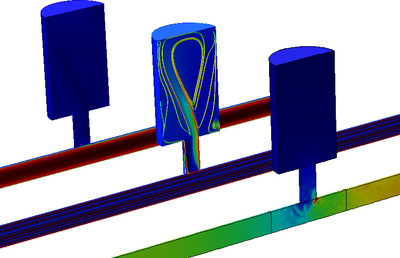Helmholtz Resonator with Flow: Interaction of Flow and Acoustics
Application ID: 35011
Helmholtz resonators are used in exhaust systems, as they can attenuate a specific narrow frequency band. The presence of a flow in the system alters the acoustic properties of the resonator and the transmission loss of the subsystem. In this tutorial model, a Helmholtz resonator is located as a side branch to a main duct. The transmission loss through the main duct is investigated when a flow is introduced.
The mean flow is calculated with the SST turbulence model for Ma = 0.05 and Ma = 0.1. The acoustics problem is then solved using the Linearized Navier-Stokes, Frequency Domain (LNS) interface. The mean flow velocity, pressure, and turbulent viscosity are coupled to the LNS model. Results are compared to measurements found in a journal paper and the amplitudes and resonance locations show good agreement with the measurement data (as seen in the 1D plot). The balance between attenuation and flow effects needs to be modeled rigorously in order for the resonance location to be correct.

この model の例は, 通常次の製品を使用して構築されるこのタイプのアプリケーションを示しています.
ただし, これを完全に定義およびモデル化するには, 追加の製品が必要になる場合があります. さらに, この例は, 次の製品の組み合わせのコンポーネントを使用して定義およびモデル化することもできます.
- COMSOL Multiphysics® and
- 音響モジュール and
- either the CFD モジュール, or 伝熱モジュール
アプリケーションのモデリングに必要な COMSOL® 製品の組み合わせは, 境界条件, 材料特性, フィジックスインターフェース, パーツライブラリなど, いくつかの要因によって異なります. 特定の機能が複数の製品に共通している場合もあります. お客様のモデリングニーズに適した製品の組み合わせを決定するために, 製品仕様一覧 を確認し, 無償のトライアルライセンスをご利用ください. COMSOL セールスおよびサポートチームでは, この件に関するご質問にお答えしています.
